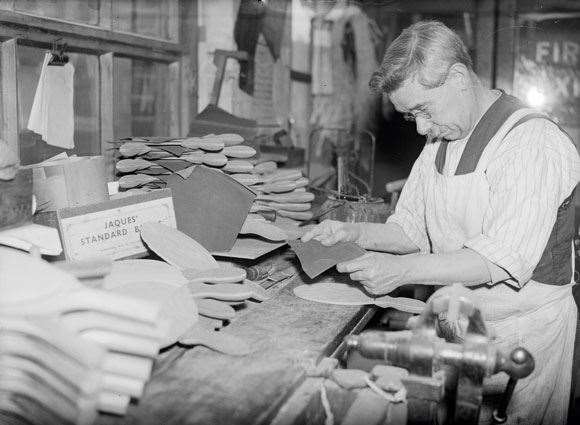Sometimes a modern game results from a long string of innovations. It seems that table tennis never stops.
Sometimes a modern game results from a long string of innovations. It seems that table tennis never stops.
 Table tennis was a popular after-dinner frolic for the well-to-do. Image: Getty Images
Table tennis was a popular after-dinner frolic for the well-to-do. Image: Getty ImagesThe very invention, and survival, of table tennis is testimony to man’s resourcefulness. The sport was born of the desire to compete, to play, no matter what the circumstance. It was the perfect pastime for its era, and is proving just as beneficial nowadays. What began as an after-dinner frolic for English aristocracy, or British army officers, or university students (depending on which story you hear) – using found objects like champagne corks, a ball of string, or even screwed up paper for “balls”, cigar box lids or thick cardboard for bats, and rows of books for a net – developed into an Olympic sport, and one of the world’s most popular leisure time pursuits.
From those early inventive parlour origins, the game proved so popular that bats, consisting of parchment or leather stretched over a wooden frame, were manufactured. The sound of these bats whooshing, followed by the “ball” hitting the table gave rise to the onomatopoeic names “wiff-waff” and “ping-pong”. Some early depictions show that players were often seated! James Gibb, an English devotee and founding member of the Amateur Athletics Association, wrought the first innovation to transform the game. On a trip to America in 1900, Gibb discovered children playing with a novelty ball made from light celluloid, and saw its possibilities. Gibb informed a business acquaintance, who immediately began to import and sell the balls. Of course, the introduction of a regular-shaped ball meant the game, already extremely popular, took off.
The next major advance was made by another Englishman, E.C Goode, who took the pimpled cash mat lying on his chemist’s counter and attached it to his own hard wooden bat. The implications were immediately apparent when Goode challenged the English champion and beat the bamboozled titleholder 50 games to three.English sporting goods manufacturer John Jacques, which registered Gibbs’ name “ping-pong”, sold the rights to America’s Parker Brothers, who were first to come up with a portable table, net, and standardised paddles. But their control of the trade name and high-cost equipment almost strangled the game.Despite this corporate contretemps, the game flourished under the generic name “table tennis”. Tournaments attracted up to 300 competitors. It waned in popularity momentarily, like most fads done to death by corporations, but around 1921 the Hon. Ivor Montagu, a son of Lady Swaythling, initiated lively games against other aficionados. His mother donated the Swaythling Cup, which became table tennis’ Davis Cup equivalent. Again, the game exploded.
 The Jacques factory made standardised paddles. Image: Getty Images
The Jacques factory made standardised paddles. Image: Getty ImagesIn 1927 the world championship became official. Way back in 1902, British businessman Edward Shires had introduced table tennis to the Austro-Hungarian empire. Now
Hungarian players ruled the game, apart from when Fred Perry (the last Englishman to win Wimbledon) won in 1929.Its spread was rapid. At the same time the Hungarians enthusiastically embraced table tennis, a Japanese professor took it home from England and changed the sport forever. From 1953 onwards, fiercely competitive, agile Asian players dominated. Gone forever were the unquestioned mores of the English, who still considered a shot like the smash distasteful and unsportsmanlike.
Table tennis has since been marked by attempts to bring to heel an increasingly difficult game. Japan’s Satoh tested its limits with a huge bat like a bath sponge on a stick. Satoh only had to touch the ball to propel it with blinding speed. The game was almost ruined, and the Table Tennis Association banned Satoh’s bat. The sandwich bat – a plywood blade with a thin layer of sponge with dimpled rubber on each side – was developed.
The offensive, spin-and-speed Asian game was further enhanced with their development of the penhold grip (the alternative is the much older shakehand), which has the bat at a constant slight tilt, especially suited for forehand topspin.The use of “speed glue”, applied just before a match to affix increasingly-thick rubber surfaces to the bat, enhanced the bat’s elasticity, until the trampolining effect saw a gradual return to the crazy days of Satoh. After the Beijing Olympics it was banned.
Add the French innovation of varying the bat’s facings – the front normal, the rear a “dead” natural rubber that can abruptly change the pace of a shot and break up the rhythm – and you have one of the world’s most testing games.Television has dictated more changes. The ball was recently enlarged from 38mm to 40mm to increase air resistance and slow the game down. To compensate, the ITTF compressed scoring from 21 points to 11.And so the evolution of table tennis, and its amazing exponents, continues.
– Robert Drane
Related Articles
.jpeg&h=172&w=306&c=1&s=1)
Langerak to bolster Victory's ALM title bid in January

Socceroo-in-waiting seals Championship deal













